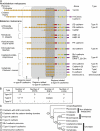Evolution: structural and functional diversity of cadherin at the adherens junction
- PMID: 21708975
- PMCID: PMC3216324
- DOI: 10.1083/jcb.201008173
Evolution: structural and functional diversity of cadherin at the adherens junction
Abstract
Adhesion between cells is essential to the evolution of multicellularity. Indeed, morphogenesis in animals requires firm but flexible intercellular adhesions that are mediated by subcellular structures like the adherens junction (AJ). A key component of AJs is classical cadherins, a group of transmembrane proteins that maintain dynamic cell-cell associations in many animal species. An evolutionary reconstruction of cadherin structure and function provides a comprehensive framework with which to appreciate the diversity of morphogenetic mechanisms in animals.
Figures




References
Publication types
MeSH terms
Substances
LinkOut - more resources
Full Text Sources
Molecular Biology Databases

